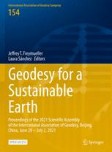Search
Search Results
-
Accounting for residual errors in atmosphere–ocean background models applied in satellite gravimetry
The Atmosphere and Ocean non-tidal De-aliasing Level-1B (AOD1B) product is widely used in precise orbit determination and satellite gravimetry to...

-
Preliminary results of the global ocean tide derived from HY-2A radar altimeter data
The HY-2A satellite, which is equipped with a radar altimeter and was launched on August 16, 2011, is the first Chinese marine dynamic environmental...
-
Radial Orbit Errors of Contemporary Altimetry Satellite Orbits
Precise orbits of altimetry satellites are a prerequisite for the investigation of global, regional, and coastal sea levels together with their...

-
Impacts of frequency-dependent instrument noise for next-generation gravimetric mission on determining temporal gravity field model
The Bender-type constellation has become a feasible option of the next-generation gravimetric mission (NGGM) for improving the quality of temporal...

-
Aliasing of ocean tides in satellite gravimetry: a two-step mechanism
Ocean tide aliasing is one of the largest error sources in satellite gravimetry. Despite its importance, the aliasing mechanism of ocean tides in...

-
Modeling gravimetric signatures of third-degree ocean tides and their detection in superconducting gravimeter records
We employ the barotropic, data-unconstrained ocean tide model TiME to derive an atlas for degree-3 tidal constituents including monthly to terdiurnal...

-
Modeling ocean-induced rapid Earth rotation variations: an update
We revisit the problem of modeling the ocean’s contribution to rapid, non-tidal Earth rotation variations at periods of 2–120 days. Estimates of...

-
Modeling total surface current in the Persian Gulf and the Oman Sea by combination of geodetic and hydrographic observations and assimilation with in situ current meter data
Surface currents in oceanic environment are of vital importance from economical, biological and environmental aspects. Modelling ocean currents has...

-
Detectability of Seamount Eruptions Through a Quantum Technology Gravity Mission MOCAST+: Hunga Tonga, Fani Maoré and Other Smaller Eruptions
Seamount eruptions alter the bathymetry and can occur undetected due to lack of explosive character. We review documented eruptions to define whether...

-
Quantifying discrepancies in the three-dimensional seasonal variations between IGS station positions and load models
Seasonal deformation related to mass redistribution on the Earth’s surface can be recorded by continuous global navigation satellite system (GNSS)...

-
The MOCAST+ Study on a Quantum Gradiometry Satellite Mission with Atomic Clocks
In the past twenty years, satellite gravimetry missions have successfully provided data for the determination of the Earth static gravity field...

-
Revisiting Force Model Error Modeling in GRACE Gravity Field Recovery
The gravity field recovery from GRACE (Gravity Recovery and Climate Experiment) mission data is contaminated by both observation noise and dynamic...

-
Applications and Challenges of GRACE and GRACE Follow-On Satellite Gravimetry
Time-variable gravity measurements from the Gravity Recovery and Climate Experiment (GRACE) and GRACE Follow-On (GRACE-FO) missions have opened up a...

-
Analysis of sub-daily polar motion derived from GPS with different temporal resolutions
This study investigates the sub-daily polar motion (PM) derived from different estimation interval solutions ranging from 5 min/2 h. By analyzing a...

-
Assessing the impact of corrections included in the GRACE Level-3 data on gravimetric polar motion excitation estimates
Between 2002 and 2017, the Gravity Recovery and Climate Experiment (GRACE) mission provided datasets of temporal variations of the Earth’s gravity...

-
Comparing GlobCurrent dataset with numerical results from a high-resolution implementation of the POLCOMS-WAM coupled system under a strong gap wind over the Gulf of Tehuantepec
GlobCurrent provides a variety of datasets aiming to describe global ocean circulation, especially when dealing with large-scale phenomena. It...

-
Using Satellite-Based Terrestrial Water Storage Data: A Review
Land water storage plays a key role for the Earth’s climate, natural ecosystems, and human activities. Since the launch of the first Gravity Recovery...

-
Analysis of Systematic Errors in Geocenter Coordinates Determined From GNSS, SLR, DORIS, and GRACE
The goal of this paper is to determine and analyze the common geocenter signal from the geocenter coordinates based on four independent techniques:...

-
The Benefit of Accelerometers Based on Cold Atom Interferometry for Future Satellite Gravity Missions
Satellite gravity missions, like GRACE and GRACE Follow-On, successfully map the Earth’s gravity field and its change over time. With the addition of...
-
Revisiting the leeway of ship** containers: a case study of the M/V Zim Kingston incident
On 22 October 2021, 109 ship** containers fell overboard from the M/V Zim Kingston in rough seas off the coast of Vancouver Island, British...

